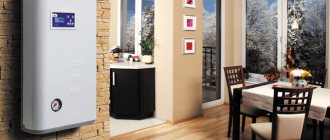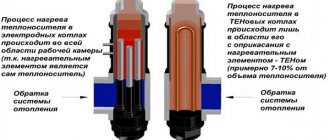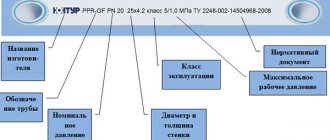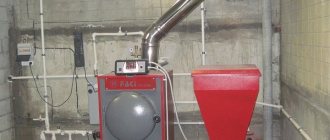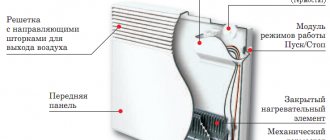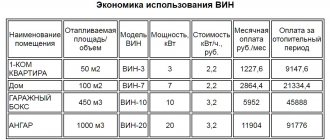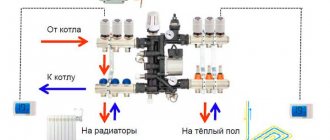Home / Electric boilers
Back
Published: 05/28/2019
Reading time: 3 min
0
1911
Purchasing a high-quality boiler for a private home is only half the way to stable operation of the equipment. Proper installation is of great importance, which determines effective heating of the premises. Incorrect wiring of the electric boiler will lead to defective, energy-consuming and unsafe operation.
This is also fraught with rapid wear. To avoid installation errors, you must follow the advice of experts and be guided by the rules and regulations. It is important to understand what kind of piping is required for an electric heating boiler and how it should be equipped.
- 1 Why do you need to properly tie an electric boiler?
- 2 Connection features
- 3 Classic piping 3.1 Electric boiler piping diagram
Features of operation and connection of the electric boiler
It would be wrong to call boiler piping a complex process; however, installing electric heating in residential and public buildings will require owners to strictly adhere to the rules and technology requirements. The main feature of the EC, compared to other heaters for individual heating circuits, is the compactness and accessibility of the installation site, due to which it can be connected to any point of the intra-house heating network.
The unit functions equally effectively in piping schemes with natural and forced movement of the heating circuit. When installing the heater at the lowest point of the circuit, a sufficiently high level of heating of the heating devices will be achieved.
There are quite a lot of standard options, so piping an electric heating boiler is a diagram that is selected for the real conditions of heat supply to the facility. However, for any of them, a reliable grounding system must be created, which must be periodically tested for functionality. This work, as well as installation and piping of the boiler and networks, must be performed by certified specialists, which is an important condition for the efficient and safe operation of the equipment in the future. It is possible to connect the unit from the subscriber electrical panel, while using the “0” phase is strictly prohibited, since the EC protection will perceive this circuit connection as a short circuit.
Connecting an electric boiler to the heating system
An electric heating boiler is a simple device, the “composition” of which includes a heat exchanger, a metal container and a controller. Its peculiarity is that electricity, rather than solid fuels, is converted into heating the coolant (water, oil or antifreeze).
Today, such devices are widely used for heating offices, warehouses, garages, and shops. An electric boiler is also popular as a component of a heating system in a private home. This is explained, first of all, by the ease of use of the device. However, such a heat generator has other advantages:
- The power control system allows you to adjust the temperature in the house as accurately as possible;
- Silent;
- It runs only on electricity, therefore it is absolutely environmentally friendly;
- Safe due to the absence of open flame;
- Such a boiler is devoid of mechanisms that directly affect each other, and therefore is resistant to wear;
- Compact;
- Does not require constant attention;
- Efficient (efficiency is 100%);
- Does not require special permission for self-installation.
The only negative is that there are frequent malfunctions during power outages or power surges. In addition, already at first after the purchase the question arises: “How to connect an electric heating boiler?” This can be done without the help of a specialist, with your own hands, if you take into account a number of features.
What is electric boiler piping
Piping an electric heating boiler is the performance of technological operations to combine all equipment into a single heat-generating complex. Its task is to transport hot coolant to heating devices to maintain a sanitary temperature of the internal air in the room.
A correctly assembled circuit of thermal and electrical equipment will protect the system from overheating and ensure its performance for a period not less than that stated by the manufacturer, for complete, uniform, and rapid distribution of heat in the house.
What does the wiring of an electric boiler look like?
Integration of EC in the heating system is carried out using the following elements:
- American women;
- water purification filter;
- shut-off and control valves;
- expansion tank;
- pipelines with branches;
- circulation pumps.
Boiler protection is carried out using:
- Pressure gauges for monitoring coolant pressure in the unit and water pipe system.
- Automatic air duct for removing “air bags” in the intra-house heating system.
- Safety relief valve that protects the system from rupture when the permissible pressure is exceeded.
A more detailed wiring diagram is provided by the manufacturer of the electric heating unit when purchasing it.
What is the harness for?
The main purpose of the piping is to prevent overheating of the electric boiler. Accordingly, a correctly executed heating boiler piping scheme can significantly save money by reducing the level of heat loss. In addition, correctly performed piping eliminates the need to use high-quality and expensive equipment that allows you to monitor the operation of the system. The need for it simply disappears.
If the electric heating boiler is not equipped with an automatic control unit, correctly installed piping is extremely important. After all, it allows you to achieve maximum efficiency from even the most powerful boiler.
Materials used
Materials for the piping circuit of an electric boiler must ensure safe operation of the equipment and comply with the requirements of state regulations and standards for operation, rules for the technical and safe operation of consumer electrical installations.
Requirements for piping electric heating boilers:
- The power supply is carried out by a copper wire with a cross-section indicated in the passport;
- grounding must be carried out in accordance with the requirements of the PUE, and checked annually for operability;
- a separate cable with an automatic safety switch must be installed;
- It is prohibited to use gas, water and sewerage systems as a grounding loop.
Before choosing a material for piping an electric boiler, you need to familiarize yourself with its technical capabilities, which affect the operation of electric heating. For pipes, important characteristics are thermal insulation properties, the ability to create complex structures and the cost of piping. The most common piping solutions are polypropylene or copper pipes.
Copper piping
Carrying out installation using copper pipes requires certain experience from the performers, and significant financial resources from the users. Advantages of copper pipes:
- High heat transfer coefficient of copper - heating of the room is carried out not only by heating devices, but also by the piping system.
- High anti-corrosion protection, although pipes become covered with a thin layer of corrosion over time, it does not affect performance.
- There is no threat of rupture of the pipeline system from freezing. This is due to the fact that copper is more ductile and can withstand freezing loads without compromising its integrity.
Piping an electric boiler with copper pipes
However, the advantages of copper cannot offset its disadvantages, which must be taken into account when choosing this pipe material for piping the system:
- High installation cost;
- Copper pipes should not be buried in the wall;
- the need for high-quality insulation;
- protection against stray currents, the effect of which is detrimental to copper.
Tying with polypropylene pipes
Many users consider polypropylene to be an ideal option for EC strapping. This pipe option is reinforced with fiberglass reinforcement to resist heat. The smooth, anti-corrosion inner surface of the pipes ensures excellent circulation speed of heating water. Installation technology using special welding equipment ensures high quality work without coolant leaks. When preparing a thermal heating scheme and dividing it into heating sections, you should take into account the features of plastic - a high coefficient of expansion and heat loss. Therefore, it is not recommended to choose areas with a long length of pipes.
Polypropylene pipes are connected in 2 ways: soldering and using fittings. The first method is the most reliable, practically does not allow leaks, the second is less reliable, even with a slight displacement - hot water begins to leak.
Modern polypropylene pipes are distinguished by long service life - 40 years or more and high strength, able to easily withstand environmental pressure up to 25 Bar. The latest modifications of these pipes have received protection against excessive expansion; today, even heating the coolant to 95 C does not cause deformation.
Connection nuances and wiring diagrams
Before calculating the heat supply scheme, a thermal calculation and selection of equipment for an electric boiler for heating are carried out. Here, the control indicator is the temperature difference of the coolant at the inlet and outlet of the boiler.
Technologically, the process proceeds in such a way that initially the network water moves along a small circuit in order to obtain the operating temperature of the hot medium, then it moves to consumers along the main heating circuit to ensure the required internal air temperature at the facility. Therefore, in order to fulfill all technological conditions, it is necessary to connect several circuits.
Typical EC heating piping projects are provided for the following options:
- with a forced circulation circuit;
- with a natural hot water flow circuit;
- classic wiring diagram;
- using primary-secondary rings.
Piping an electric boiler with a natural hot water circuit
Why do you need boiler piping?
Purposes of strapping:
- protects the boiler;
- creates optimal working conditions;
- ensures a constant temperature in the rooms.
To protect the boiler, devices are used to monitor temperature and pressure. Using a buffer tank makes it possible to accumulate hot water. The scheme is useful for two-tariff calculations.
At night, when electricity is cheaper, the boiler operates at full capacity, during the day it turns off or operates at minimum power. Balancing underfloor heating and radiators allows you to achieve the same temperature in different rooms.
Sequence of work
A typical piping diagram assumes the location and sequence of equipment installation, the pipe system, the type and type of equipment, the number of circuits, the type of heating elements, the electrical circuit with equipment and protection devices. When the heating system has a high resistance, for example, multi-circuit heating or a “warm floor” system, then a circular electric pump is installed.
Strapping sequence:
- First, install the boiler securely on the wall or floor. The heating element unit is fixed at least 1.5 m from the floor level, induction or electrode devices are fixed lower, according to the piping conditions.
- Install the distribution manifold from the boiler.
- Attach pipes of the required diameter to the inlet and outlet pipes of the EC.
- A three-way valve with a mixer function is installed to regulate the temperature of the coolant.
- Mount the circulation pump on the return line.
- Install heating boiler protection devices, consisting of 2 valves and a pressure gauge installed at the outlet of the EC.
Piping diagram of a natural circulation system
A typical heating system for objects based on the principle of natural coolant circulation requires the installation of the following basic elements:
- Room thermostat for temperature regulation;
- heating devices - radiators and convectors;
- open type air tank;
- shut-off and control valves and taps for feeding the network circuit.
The technology for piping an electric boiler with natural movement of the medium is simple and accessible for self-installation.
It is simplified due to the absence of a pump to move the coolant. Heated water moves along a contour made with strict observance of slopes, thanks to the physical laws of movement of hot and cold media. It is applicable for individual heating of one-story buildings with small heating areas.
Forced circulation piping
In this scheme, the circulation pump is additionally connected: a bypass line, power supply, shut-off and control valves and a security system with temperature and pressure sensors. This is the most optimal scheme for automatic control of heating and hot water levels. The owner of the facility can choose different temperatures for different rooms, although this will require an increase in the cost of heating due to the cost of electricity to operate the pump.
Algorithm for piping an electric heating boiler, diagram of a heating element electric boiler:
- The outlet pipes are connected to the network pipeline through ball valves and an American connection.
- A membrane-type expansion tank and a mesh filter are installed in the return line to filter suspended sludge and debris in the network water.
- To clean the mud pan, a ball valve is installed in front of it.
- A circulation pump is installed in circuits with forced circulation; if it is not included in the boiler delivery set, then it is purchased additionally, the selection is carried out according to the volume of water that is cooled along the boiler contour and indicated in the passport.
- A safety group is installed: a pressure gauge, an air vent and a safety relief valve that prevents pressure from increasing in the system.
Heating a house with solid fuel and electric boilers - how to do it
Heating a house with a solid fuel boiler is not expensive. But it's troublesome. Electricity, on the contrary, is more expensive, but the most comfortable of all types of energy carriers.
It is a good idea to complement a solid fuel boiler with an electric one, which will greatly simplify the maintenance of heating in the house and the convenience of living. It will be possible not to wake up at night to maintain heating with solid fuel, and also to leave the house for a long time without freezing the building, or simply maintain heat with electricity when there is no time to deal with firewood.
It is advisable to apply for a “night tariff” for electricity supply, which is much cheaper than the day tariff. Then the automated electric boiler will be able to heat the house at night, and not just maintain the temperature.
In general, heating with two boilers - solid fuel and electric - is a convenient scheme that is gaining popularity.
It remains to figure out how to heat a home using two heat generators - solid fuel and electric, how to connect correctly, what kind of automation is required so that the operation of the units is coordinated and sequential.
Features of selecting pumps for a scheme with two boilers
An electric automatic device is equipped with an internal circulation pump, and for solid fuel, this pump must be installed separately, on the return line, after the cleaning filter and expansion tank.
Installing this pump on the supply side is not advisable, since if the liquid boils, this pump will not be able to pump steam and the movement of the coolant in the system will stop. Therefore, the boiling process will develop, the temperature in the heat exchanger will increase until either the heat exchanger itself or the connected plastic pipeline fails.
With a solid fuel boiler, the circulation pump is installed on the return line, where it will remain operational even when the liquid boils and prevent the development of this dangerous process.
It is also necessary to pay attention to the pressure that the pumps must develop. As a rule, an electric boiler is equipped with a pump that develops pressure up to 0.4 or a maximum of 0.5 atm, designated, for example, 15/50 (the first number indicates the diameter of the connected pipelines, the second - the pressure). This pump works constantly, driving coolant through the system.
But when two pumps operate simultaneously, if the electric one “overpowers” the solid fuel one, then in the latter the fluid movement will stop or overturn. It will boil, causing a serious accident. If the solid fuel “transmits”, then nothing bad will happen - the automated electric boiler will simply turn off if the temperature of the air or coolant exceeds a certain set value.
Therefore, a device with solid fuel must be equipped with a pump that develops a higher pressure than the pump in an electric boiler, for example 25/60 - 0.6 atm.
The superiority of the solid fuel heat generator pump in terms of pressure is a mandatory condition for switching on according to this scheme.
Connection diagram, check valves
Solid fuel and electric boilers are connected to the main supply and return pipelines in parallel.
But so that the operation of one of them does not affect the operation of the other, check valves are installed at the supply outlet of each of them, after the taps.
Then the injection of liquid by one pump will not affect the other unit, or rather, the jet will not overturn and a small circle of circulation will not occur with the most negative consequences.
The heating system of a house consisting of two boilers is necessarily equipped with a supply safety group, which includes a pressure gauge, an overpressure emergency valve, and an air bleed valve.
On the return line, a mud filter should be installed with the sludge collector facing down, or at least inclined downwards, as well as a drain valve into the sewer, a system injection valve (connection to the water supply), and an expansion tank that compensates for the increase in pressure when the liquid is heated. Its initial pressure (pumped by an air pump) is usually 1.5 atm. And the volume must be at least 0.1 of the amount of liquid in the system.
Automation means
The solid fuel boiler is equipped with a thermostat, which opens the electrical contacts to control the pump, and its remote sensor is installed at the outlet of the heat exchanger. If the coolant cools down, i.e. If the wood burns out, the thermostat will turn off the pump. Setting - no more than 30 degrees.
Why is it needed? The fact is that there will always be draft through the chimney. When the boiler goes out, it will turn into a good cooling radiator for the coolant, the heat from which is carried away to the sky. If the pump continues to circulate liquid, the coolant will cool rapidly.
When the boiler is melted, the temperature of the liquid at the outlet will quickly increase, and the thermostat will immediately turn on this pump.
Also, this pump must be equipped with an uninterruptible power supply - an uninterruptible power supply. A power outage, even for 15 minutes, can lead to boiling of liquid and destruction of equipment. The movement of fluid should not stop.
For an electric automated device, a room temperature sensor is connected. It registers the air temperature in the room and, in accordance with the automation settings, gives a command to turn on when the air cools down, for example, below 20 degrees, and then to turn off if the temperature, for example, reaches 22 degrees. Those. When the solid fuel boiler starts working, the temperature in the house will rise quickly.
The electric heat generator learns from the air sensor “that it is no longer needed” and stops. As the temperature decreases, when the solid fuel one goes out, the electric one turns on in the mode assigned to it and will maintain the room temperature above 20 degrees C (night mode).
You can make a similar heating scheme for a house with two boilers with your own hands, if you have plumbing skills. And setting up the system will come down to selecting the temperature on the sensors so that the electric one turns on on time, and the solid fuel pump does not turn off before the flame finally goes out.
Ensuring the constant operation of the circuit pump with solid fuel is the priority of using such heat generators in any circuit, including paired not only with an electric, but also with a gas boiler... You can also read about connecting an indirect heating boiler to a solid fuel boiler.
